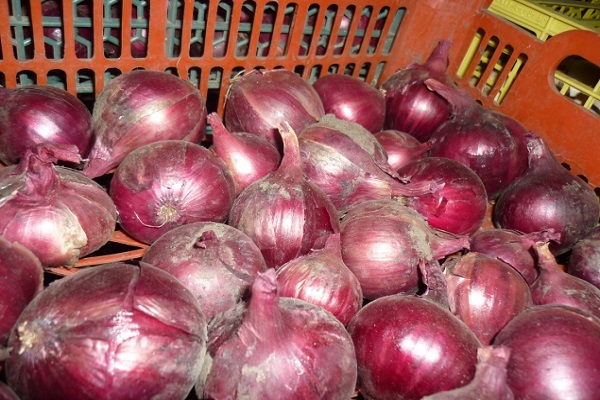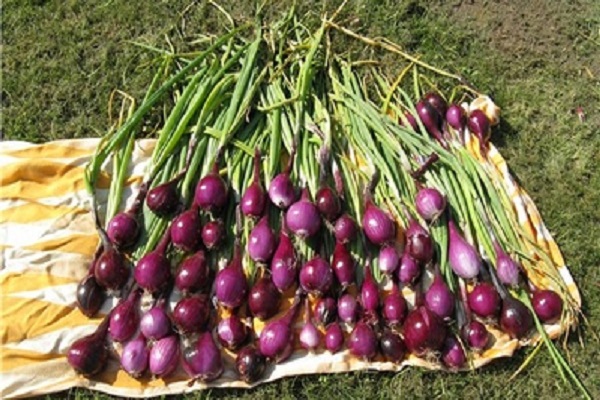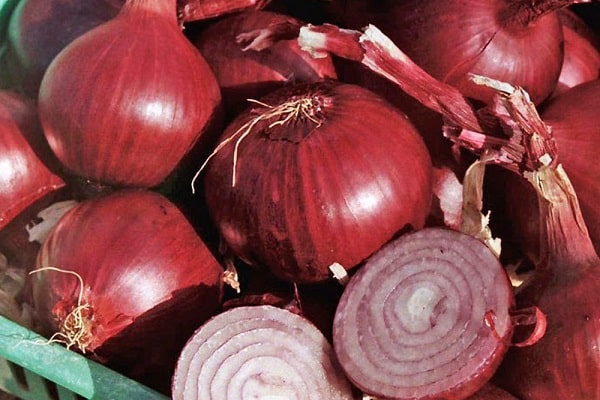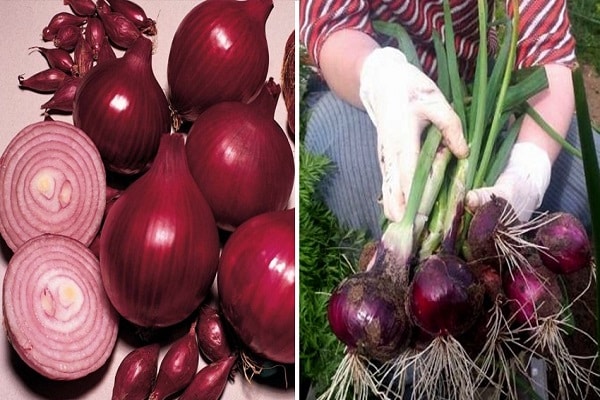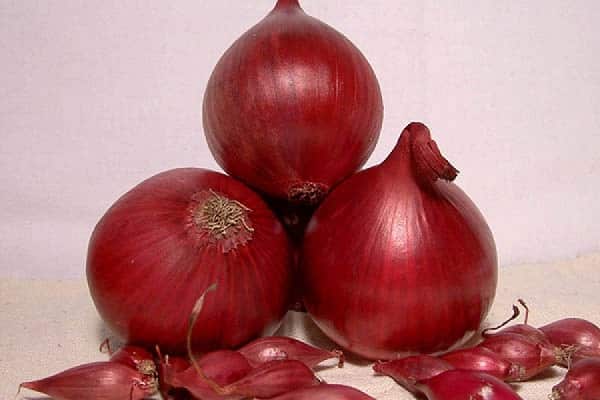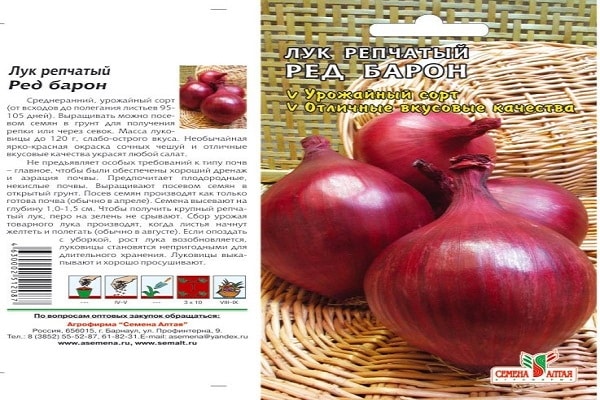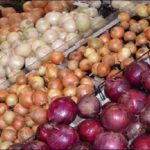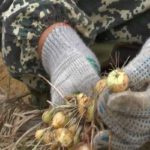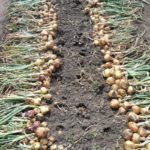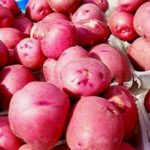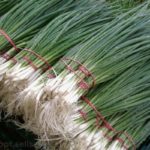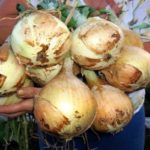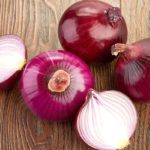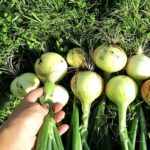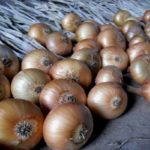Red Baron onion is one of the varieties developed by Dutch breeders. The hybrid is endowed with high yield, disease resistance and unpretentiousness to the environment.
Description
The growing season lasts 90–105 days. The round, slightly flattened bulb is covered with dense scales. The color of the outer scales is wine, the inner ones are light purple. The taste of the vegetable is semi-sharp, the smell is strongly bulbous. Productivity - 3 kg per 1 sq. m.
It is known that each variety has advantages and disadvantages. What are they like on the Red Baron bow?
Pros of culture:
- Short ripening period. Thanks to this feature, the crop can be grown in northern regions where other varieties rarely ripen.
- Great weight and good presentation.
- Keeping quality. If you follow simple rules, the bulbs are stored until the beginning of summer.
- Disease resistance.
- Powerful root system. Numerous shoots effectively pull the elements necessary for growth from the soil.
- Coloring. The beautiful rich color does not disappear during storage and does not transfer to other ingredients during the preparation of multi-component dishes.
- Compound. The purple variety of onion contains a large amount of antioxidants, dry matter, and vitamin C.
This bow has much fewer disadvantages than advantages, and they are insignificant, so the description of the Red Baron bow is almost flawless. List of weaknesses:
- Low quality seeds. Due to this factor, the Red Baron variety is primarily grown from seeds.
- Inability to prepare planting material yourself. Seeds have to be purchased annually from distributors.
Features of cultivation
Everyone knows that descriptions can turn out to be meaningless words if planting and care are done incorrectly. Growing Red Onions begins with preparing the soil and planting material.
The area chosen for cultivation is sprinkled with humus or compost in the fall and dug up. For 1 sq. m of area consumes 3 kg of organic substances. Fans of industrial fertilizers add 15 g of potassium nitrate and nitrophoska for digging.
To prevent pathogens from damaging the crop and to make it possible to appreciate the characteristics of the variety, the thawed soil is watered with a solution of copper sulfate (1 tbsp per 10 liters of water). After treatment is completed, the area is covered with thin material for 48–72 hours. Before planting onions, the soil is fluffed up and leveled.
The principle of preparing planting material varies depending on the type:
- Seeds. First of all, the onions are checked for germination. To do this, pour the seeds into a container with warm water and wait for some time. After that, the floating seeds must be removed, since the likelihood that they will sprout is minimal. The remaining material is alternately poured with hot and cold water for half an hour.
- Sevok. The largest ones are selected from the available bulbs. As a rule, by the time of spring planting, small specimens dry out and do not sprout. To speed up the emergence of seedlings, the seedlings are kept near the radiator for 3 days, where the temperature is kept at 30–40 degrees. Immediately before planting, remove the planting material from a warm place and soak it in a solution of copper sulfate.
To get a truly generous harvest, you need not only to prepare the seeds correctly, but also to plant them correctly. The optimal time for planting the Red Baron onion variety is from May 1 to May 10. Thanks to suitable weather conditions, the crop does not bolt and bears fruit abundantly.
Onions are planted in rows located from south to north. The distance between the grooves is 15 cm, the bulbs are 8 cm. Care includes:
- Watering. If the weather is dry, water is added to the bulb bed once a week. During the period when precipitation falls regularly, the need for irrigation is determined by the condition of the soil. If the soil squeezed in the palm has broken up into small pieces, the onions are watered, but the spruce remains in one lump - no. To ensure that turnips do not lose their taste and are stored for a long time, watering is stopped with the arrival of July.
- Feeding. If the plants look lethargic and grow slowly, they are watered with a solution of nitrate or microfertilizer.During the period of turnip formation, a superphosphate solution is added under the onions (2 tablespoons per bucket of water).
Remove the onion after the neck has completely dried on a sunny, fine day. The turnips are carefully shaken from adhering soil and laid out on burlap in the open air. In cases where there is a risk of precipitation, the crop is dried under a canopy or in a ventilated room. After half a month, the feathers are trimmed, the onions are sorted and placed in boxes.
Reviews
Nowadays, gardeners rely not on the description of the variety, but on the opinions of colleagues who have tested the plant in practice. What do vegetable growers think about Red Baron onions?
- Marina, Moscow region: “I have been growing the Red Baron variety for several years by sowing sets in open ground. During this time, the variety has demonstrated resistance to low temperatures and good keeping quality.”
- Ivan, St. Petersburg: “I plant red onion sets immediately after the soil dries out a little from melt water. Red Baron pleases with its unpretentiousness to conditions and rich original taste.”
- Lyudmila, Chelyabinsk region: “Among the tried varieties, Red Baron occupies one of the most honorable places in my ranking. Turnips are not only beautiful, but also tasty. I use onions for preparing salads and main dishes.”
As you can see, the reviews about this onion variety are only positive, which allows you to grow the crop on your site without hesitation.
Red Baron onion is a good table variety that differs from other types in its original taste and is tolerant of cold weather. Thanks to its unusual color and long shelf life, the onion variety is equally suitable for obtaining turnips for your own needs and for sale.

